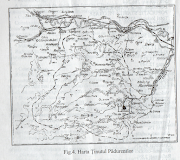 Travelling from Huniad Castle about 20 km in Govajdia village from Ghelar commune you will find an old furnace build at the beginning of XIX century. It was included in National Heritage sites from 2000 on the list of Historic Monuments in Hunedoara County.
Travelling from Huniad Castle about 20 km in Govajdia village from Ghelar commune you will find an old furnace build at the beginning of XIX century. It was included in National Heritage sites from 2000 on the list of Historic Monuments in Hunedoara County.Construction began in 1806, and although finished in 1810. A tablet placed on the front of the furnace read: Augusto Imperante Francisco Extructum 1810 ("Built 1810 during the reign of the venerable Francis")
Opened in April 1810, the blast from Govajdia have production flow continuously and represent the beginning of the XIX century the modern "laboratory" where mixing silicon manganese, iron ore is transformed magically into much-needed iron.
The furnace was built on the site of a forge, Old Limpetrul that work in 1674 at the confluence Runc and Nadrab.
Legend holds that metal prepared here was used for raw material in the building of the Eiffel Tower, but there is no documentary evidence in support of this claim.
The furnace was built on the site of a forge, Old Limpetrul that work in 1674 at the confluence Runc and Nadrab.
Legend holds that metal prepared here was used for raw material in the building of the Eiffel Tower, but there is no documentary evidence in support of this claim.
This success in the development of metallurgy in Transylvania, occupied by Austria-Hungary was, therefore, a climate and a quilt over many centuries. So many blacksmith workshops functioned Govajdiei area today, including one at Nadrab was mentioned since 1517 in 1754 featuring three ovens and a confluence forge. At Runc and Nadrab there Limportul Lower workshop producing 180- 190 tons of forged steel and steel bars in 1849.
The beginning of modern metallurgy began three decades earlier Pădurenilor County in 1781, it began to produce furnace Topliţa, Cerna Valley. The Govăjdie brought, however, the benefits of new technologies and consequently greater productivity.
Originally produced 640 tons of iron per year, to reach, in 1852, after modernization, an annual output of 4,000 tons.
The furnace worked until 1918. The furnace construction started in 1806 and ended in 1810. The amount allocated for construction proved to be insufficient because this amount was enough just to build furnace, furnace hall and adduction of water. That's what Samuel Matz, owner Smitheries with József Asztalos, master carpenter drew up new investment projects that included the construction of a smelter foreman housing.
From building projects remained only bridge project load and store charcoal project. On December 10, 1808 Asztalos Matz and prepared other projects which in turn are approved by the Treasury. According to the project to build the dam on the river Runc price of 3691 HUF 5 farthings and cleaning water feed channel from the dam on the river Nădrab cost 430 forints. Thus the works for the construction of the plant was completed in 1813. Together with all final investment sum amounted to 98 728 forints 50¼ farthings.
The beginning of modern metallurgy began three decades earlier Pădurenilor County in 1781, it began to produce furnace Topliţa, Cerna Valley. The Govăjdie brought, however, the benefits of new technologies and consequently greater productivity.
Originally produced 640 tons of iron per year, to reach, in 1852, after modernization, an annual output of 4,000 tons.
The furnace worked until 1918. The furnace construction started in 1806 and ended in 1810. The amount allocated for construction proved to be insufficient because this amount was enough just to build furnace, furnace hall and adduction of water. That's what Samuel Matz, owner Smitheries with József Asztalos, master carpenter drew up new investment projects that included the construction of a smelter foreman housing.
From building projects remained only bridge project load and store charcoal project. On December 10, 1808 Asztalos Matz and prepared other projects which in turn are approved by the Treasury. According to the project to build the dam on the river Runc price of 3691 HUF 5 farthings and cleaning water feed channel from the dam on the river Nădrab cost 430 forints. Thus the works for the construction of the plant was completed in 1813. Together with all final investment sum amounted to 98 728 forints 50¼ farthings.
At Tulea since 1754, it was located on the river Govajdia a forge. In order to have access to raw materials in the hamlet Catanas was built between 1888- 1894. a 747 meters tunnel which was a narrow gauge railway that circulated coaches loaded with riches of the earth, so rare in other places.
Good to know about the existence of a construction Related Industry heritage, only 20 kilometres from the city Hunedoara, Govajdia blast furnace in which it will find more or less ready to impress century history is that we XXI.

























0 Comments